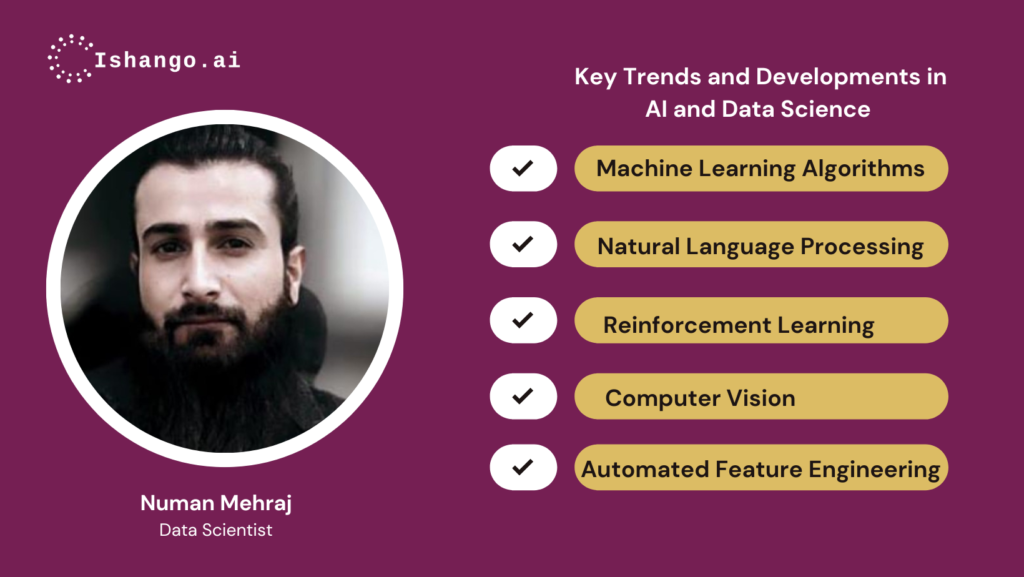Key Trends and Developments in AI and Data Science

Numan Mehraj is a data scientist who is passionate about extracting meaningful insights and actionable strategies from raw data. Throughout his career, he has worked on a variety of projects spanning different industries, including for renowned companies like Amazon, IBM, and JP Morgan. Below, he shares his thoughts on the key trends and developments in the AI and data science fields.
What are some of the key trends or developments in AI and data science that you are most excited about, and how do you see these shaping the future of the field?
Machine Learning Algorithms: Employ a variety of machine learning algorithms, such as regression, classification, clustering, and deep learning, to build predictive models and uncover patterns in the data. These models can be used for tasks like forecasting, anomaly detection, customer segmentation, and recommendation systems.
Natural Language Processing (NLP): NLP techniques enable the analysis and extraction of insights from unstructured text data, such as customer reviews, social media posts, or support tickets. You may use techniques like sentiment analysis, named entity recognition, topic modeling, and text classification to derive valuable information from textual data.
Computer Vision: If you work with visual data, computer vision techniques come into play. You can use AI models, such as convolutional neural networks (CNNs), to analyse images or videos, perform object detection, image classification, and facial recognition, or even develop autonomous systems like self-driving cars.
Automated Feature Engineering: AI can assist in automating the feature engineering process. You can use techniques like automated feature selection and extraction algorithms, or even employ AutoML (automated machine learning) tools that automatically search for the best set of features to optimise model performance.
Reinforcement Learning: In certain scenarios, I apply reinforcement learning techniques to optimise decision-making processes. For example, you can use reinforcement learning algorithms to train models that learn from feedback and improve their performance over time, such as when optimizing pricing strategies or resource allocation.
Model Optimization and Hyperparameter Tuning: AI can help streamline the process of optimizing models by automating hyperparameter tuning. You can leverage techniques like genetic algorithms, Bayesian optimization, or grid search to find the best combination of hyperparameters for your models.
Automated Data Cleaning and Preprocessing: AI tools and techniques can assist in automating data cleaning and preprocessing tasks. For instance, you can use algorithms to detect and handle missing values, outliers, or inconsistencies in the data, saving time and improving data quality.
Explainable AI: The demand for transparency and interpretability in AI models is increasing. Explainable AI techniques aim to provide understandable explanations for the decisions made by AI models, especially in critical domains such as healthcare, finance, and autonomous vehicles. This trend is crucial for building trust in AI systems and ensuring ethical decision-making.
Ethical AI and Responsible Data Science: With the growing impact of AI on society, there is a heightened focus on ethical considerations. Data scientists are becoming more aware of the potential biases, fairness issues, and privacy concerns associated with AI algorithms. The field is placing greater emphasis on developing ethical frameworks, guidelines, and responsible AI practices to ensure that AI is developed and used in a socially responsible manner.
Federated Learning and Privacy-Preserving AI: Federated Learning allows multiple parties to collaborate on model training without sharing their raw data. This approach preserves data privacy and security while enabling the benefits of centralised model training. Privacy-preserving AI techniques, such as differential privacy, secure multi-party computation, and homomorphic encryption, are gaining importance as organizations strive to protect sensitive user data while deriving insights.
AI at the Edge: With the proliferation of Internet of Things (IoT) devices and the need for real-time processing, AI is increasingly being deployed directly on edge devices. Edge AI brings the power of AI algorithms closer to the data source, enabling faster inference, reduced latency, and improved privacy. This trend opens up new opportunities for applications such as autonomous vehicles, smart cities, and healthcare monitoring.
AutoML and Automated AI: AutoML tools and platforms are making AI more accessible to non-experts by automating various stages of the machine learning pipeline, including data preprocessing, feature engineering, model selection, and hyperparameter tuning. This trend democratises AI and empowers domain experts to leverage AI techniques without extensive programming or data science knowledge.
Reinforcement Learning Advancements: Reinforcement learning, a branch of AI that involves learning optimal decision-making through trial and error, is witnessing significant advancements. Techniques like meta-learning, hierarchical reinforcement learning, and model-based reinforcement learning are enabling more efficient and generalisable learning in complex environments. These developments have the potential to revolutionise areas such as robotics, autonomous systems, and game-playing AI.
